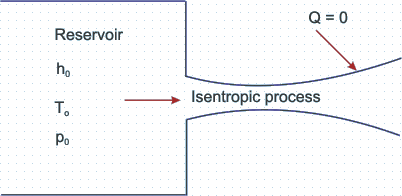Contd.
Note that in general the stagnation properties can vary throughout the flow field.
Let us consider some special cases :-
Case 1: Adiabatic Flow:
 (from eqn 39.10) is constant throughout the flow. It follows that the (from eqn 39.10) is constant throughout the flow. It follows that the
 are constant throughout an adiabatic flow, even in the presence of friction. are constant throughout an adiabatic flow, even in the presence of friction.
Hence, all stagnation properties are constant along an isentropic flow. If such a flow starts from a large reservoir where the fluid is practically at rest, then the properties in the reservoir are equal to the stagnation properties everywhere in the flow Fig (40.1)

Fig 40.1: An isentropic process starting from a reservoir
Case 2: Sonic Flow (Ma=1)
The sonic or critical properties are denoted by asterisks: p*, ρ*, a*, and T* . These properties are attained if the local fluid is imagined to expand or compress isentropically until it reaches Ma = 1.
Important-
The total enthalpy, hence T0 , is conserved as long as the process is adiabatic, irrespective of frictional effects.
From Eq. (40.1), we note that
This gives the relationship between the fluid velocity V, and local temperature (T), in an adiabatic flow.
Putting T=0 we obtain maximum attainable velocity as,
 |
(40.5b) |
Considering the condition, when Mach number, Ma=1, for a compressible flow we can write from Eq. (40.2), (40.3) and (40.4),
 |
(40.6a) |
 |
(40.6b) |
 |
(40.6c) |
- For diatomic gases, like air
 , the numerical values are , the numerical values are

- The fluid velocity and acoustic speed are equal at sonic condition and is
We shall employ both stagnation conditions and critical conditions as reference conditions in a variety of one dimensional compressible flows.
|